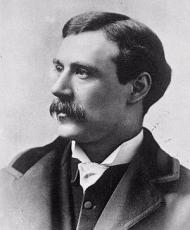William Friese-Greene (7 September 1855 – 5 May 1921) (born William Edward Green) was a British portrait photographer and prolific inventor. He is principally known as a pioneer in the field of motion pictures and is credited by some as the "inventor" of cinematography, although his work post-dates that of Louis Le Prince, who successfully shot the world's first moving pictures in Leeds in 1888.
Career
William Edward Green was born on 7 September 1855, in Bristol. He was educated there at Queen Elizabeth's Hospital. In 1869 he became an apprentice to a photographer named Maurice Guttenberg. By 1875 he had set up his own studios in Bath and Bristol, and later expanded his business with two more studios in London and Brighton. He married Helena Friese on 24 March 1874, and decided to modify his name to include her maiden name.
In Bath he came into contact with John Arthur Roebuck Rudge. Rudge was a maker of a number of instruments but had begun to specialise in the creation of magic lanterns. He had recently developed the 'Biophantic Lantern'. The lantern was unique in that it could display seven slides in rapid succession, and produce an effective illusion of movement. Friese-Greene was fascinated by the machine and in 1886 he began work with Rudge on enhancing it in order to project photographic plates. They called the device a 'Biophantascope'. Friese-Greene realised that glass plates would never be a practical medium for true moving pictures and in 1885 he began to experiment with oiled paper and by 1887 was experimenting with celluloid as a medium for motion picture cameras.
On 21 June 1889, Friese-Greene was issued patent no. 10131 for his 'chronophotographic' camera. It was apparently capable of taking up to ten photographs per second using perforated celluloid film. A report on the camera was published in the British Photographic News on 28 February 1890. On 18 March, Friese-Greene sent a clipping of the story to Thomas Edison, whose laboratory had been developing a motion picture system known as the Kinetoscope. The report was reprinted in Scientific American on 19 April. Friese-Greene gave a public demonstration in 1890 but the low frame rate combined with the device's apparent unreliability made an unfavourable impression. In the early 1890s he experimented with cameras to create stereoscopic moving images but met with limited success. Friese-Greene’s experiments in the field of motion pictures were at the expense of his other business interests and in 1891 he was declared bankrupt. To cover his debts he sold the rights to the 'chronophotographic' camera patent for £500. The renewal fee was never paid and the patent eventually lapsed.
Friese-Greene resided at Cliff Road Dovercourt, Harwich from 1897 to 1904.
Friese-Greene's later exploits were in the field of colour in motion pictures. Working in Brighton, he experimented with a system known as Biocolour. This process produced the illusion of true colour by exposing each alternate frame of ordinary black and white film stock through two different coloured filters. Each alternate frame of the monochrome print was then stained red or green. Although the projection of Biocolour prints did provide a tolerable illusion of true colour, it suffered from noticeable flickering and red and green fringing when the subject was in rapid motion.
Friese-Greene found it impossible to exhibit Biocolour motion pictures because a rival system—developed by George Albert Smith and Charles Urban and known as Kinemacolor – claimed that any colour film was an infringement of their prior patent. With the financial assistance of the renowned British racing driver Selwyn Francis Edge, Friese-Greene attempted to invalidate Urban's patent in court. Friese-Greene claimed that the patent did not contain enough detail to encompass the Biocolour process. The judge ruled in Urban's favour, but an appeal in the House of Lords in 1914 reversed the decision. Friese-Greene's system was still in its infancy and he was unable to exploit this success. His son Claude Friese-Greene continued to develop the system during the 1920s. Claude went on to become a successful cinematographer.
In 1921 Friese-Greene was attending a film and cinema industry meeting in London. The meeting had been called to discuss the current poor state of the British film industry. Disturbed by the tone of the proceedings Friese-Greene got to his feet to speak but soon became incoherent. He was assisted in returning to his seat, and shortly afterward slumped forward and died. His grave can be found in London's Highgate Cemetery. His memorial describes him as "the inventor of Kinematography".

